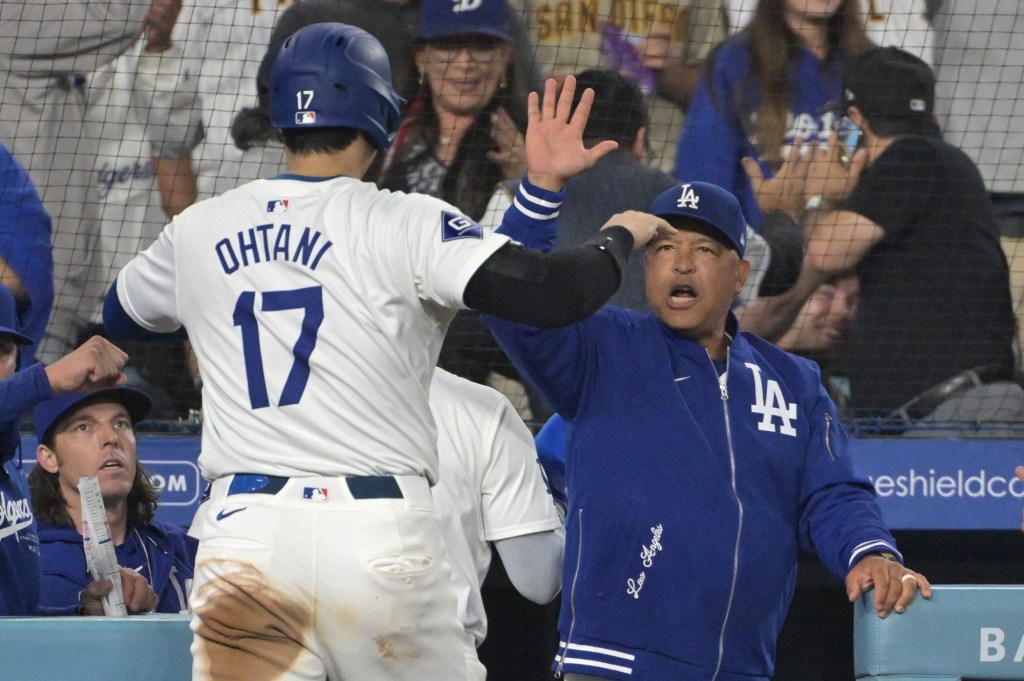The biggest stars in the biggest games. It’s a simple formula for developing fandom—but one that has eluded Major League Baseball for the past decade. Until now.
MLB’s counterparts among the other major U.S. men’s pro leagues have had little problem in this area. Chiefs quarterback Patrick Mahomes has played in four Super Bowls and won three, driving record viewership for the NFL in the process. Lakers forward LeBron James has won four NBA titles across three different teams, reached eight straight NBA Finals from 2011 to 2018, and is still a major draw at nearly 40 years old. Oilers center Connor McDavid led his team in June to the Stanley Cup Final and helped generate similarly robust viewership for the NHL.
For 10 long years, MLB didn’t get a whiff of such a megastar-driven postseason bump. Two of its most celebrated figures and those holding the unofficial title of “best player in baseball,” Mike Trout and Shohei Ohtani, have been entirely out of the postseason since 2014, driven heavily by the long malaise of the Angels.
The 2024 postseason, however, offers a very different story for MLB. Ohtani, now with the Dodgers and coming off a historic season as the sport’s first player with 50 home runs and 50 stolen bases in a season, will make his playoff debut Saturday in the Division Series against the Padres.
Not surprisingly, the “Shotime” of Ohtani is the foremost storyline of these playoffs, and his presence there and accomplishments during the season are being actively marketed both in the U.S. and his native Japan. But he will be joined among MLB’s final eight teams by the Yankees and star outfielder Aaron Judge, also absent from last year’s postseason, and the Phillies and first baseman Bryce Harper.
Collectively, Ohtani, Harper, and Judge were MLB’s three most popular player jerseys, in that order, this season.

“Having Ohtani on this stage is great for the game, great for the fans, and he’s having such a historic season,” MLB deputy commissioner Noah Garden tells Front Office Sports. “For everybody to be able to see him on this big [postseason] stage is good and important.”
Even Ohtani’s teammates are giddy about Ohtani finally getting the playoff limelight.
“I’m just like the fans,” Dodgers infielder/outfielder Mookie Betts said. “I’m looking forward to seeing Shohei play in the postseason.”
While stating the obvious truth about Ohtani, Garden was also quick to also spotlight the other major talents on the October stage, particularly Judge.
“Judge is having as good a monster season as well, and we’ve got a lot of our amazing, young players in there, too,” he says. “We’re going to be showcasing our best players, that’s for sure.”
Broader Storylines
Among the remaining contenders, there is an obvious World Series matchup that MLB and Fox, domestic broadcaster for the Fall Classic, would like to see, even if they don’t necessarily say it explicitly: the Dodgers and Yankees. In addition to the grouping of Ohtani and Judge, the teams are two of MLB’s most popular franchises, No. 1 and No. 6 all time in World Series championships, have a rich history of Fall Classic matchups dating more than 80 years, and offer an optimal geographic spread with the top two U.S. media markets.
A Dodgers-Yankees matchup would also directly build on the existing business strength of both franchises. The Dodgers led MLB in attendance for the 11th consecutive season in 2024, while the Yankees ranked fourth. Both teams are also consistently among league leaders in local game viewership and are popular draws on the road.

“It’s easy to like him, easy to root for him, fun to watch him,” Dodgers manager Dave Roberts said of Ohtani. “It’s been amazing on the road, just seeing how many people come to just watch him play, and when he takes his last at-bat, people tend to leave the ballpark. People just like to watch greatness. And he’s going to go down as one of the greats of all time.”
Well aware of the often-fickle nature of postseason play, MLB and its broadcast partners know they have to be well prepared for all sorts of potential outcomes, including ones without the Yankees and Dodgers.
“This is why it’s important for us to highlight all the storylines,” Garden says. “While obviously putting Shohei and Judge, after their historic seasons, on the biggest stage is vitally important to us, it’s not the only storyline out there. We will make sure we’re doing a good job of amplifying all of them.”
Single-Issue Litmus Test
Ohtani’s presence in the playoffs is likely to help produce a viewership bump, something that would certainly be welcome after last year’s 8% postseason ratings decline and record-low viewership for the Rangers’ World Series win over the Diamondbacks. Even before the Dodgers started playing, this year’s wild-card series generated the best viewership for that round since the current, 12-team playoff format began in 2022. Viewership on ESPN, which exclusively showed the wild-card round across a battery of Disney-owned networks, averaged 2.8 million per game, up 25% from a year ago.
For many Octobers, though, World Series viewership, or postseason viewership more broadly, has been often viewed as a single, determining factor on the health of MLB. Such a view precludes a more detailed or nuanced evaluation of the league. Focusing strictly on postseason ratings also doesn’t take into account elements such as attendance, which just posted a second-straight annual increase for the first time since 2012; youth participation in the U.S., which reached a recorded high of 16.7 million; or digital consumption, which saw a 14% bump in MLB.TV consumption to a league-record 14.5 billion minutes.
“I think that’s all starting to change,” Garden says. “As time has gone on, I’ve seen that [TV-focused] narrative shift and people have been able to see what’s happening with us on all the mediums and everything that’s out there.”



